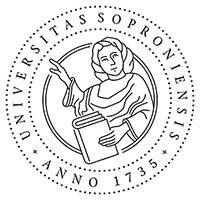Communicational Polisemy
Abstract
The word ’communication’ is a polysemantic lexical unit: it is used with several different meanings in scientific and everyday discourses as well. Focusing on this polysemanticity is constantly essential not only in our everyday life situations but in our research and pedagogical parctice and in conciliation of "brought" communication representations with definitions builded into the curriculum. Different represenatiton areas could point in these cases to different concept cores.
References
Béres István, Horányi Ö. (szerk.) (2001): Társadalmi kommunikáció. Osiris Kiadó, Budapest
Biber, Douglas; S. Conrad; R. Reppen (2001): Corpus Linguistics. Investigating Language Structure and Use. Cambridge University Press, Cambridge
Bibok Károly; Németh T. E. (szerk.): Általános nyelvészeti tanulmányok XX. Tanulmányok a pragmatika köréből. Akadémiai Kiadó, Bp. 2004, 325 p. (Bibok Károly: A szójelentés lexikai pragmatikai megközelítése, pp. 37-77; Németh T. Enikő: A kommunikatív nyelvhasználat elvei, 221–254.)
Bibok Károly; Németh T. E.: How the lexicon and context interact in the meaning construction of utterances. In: Németh T., E., Bibok K. (szerk.): Pragmatics and the flexibility of word meaning. Elsevier, Oxford, 2001. 291–320. doi: https://doi.org/10.1163/9780585474267_015
Bibok Károly; Németh T. E.: Lexikai és kontextuális információk interakciója a megnyilatkozás-jelentés megalkotása során. In: Maleczki Mária (szerk.): A mai magyar nyelv leírásának újabb módszerei V. Szegedi Tudományegyetem, Szeged, 2002. 335–367.
Domschitz Mátyás: Bevezető tanulmány. ORTT Stratégiai Kutatások és Elemzések, Bp. 2004-2005.
Fodorné Tóth Krisztina: „Kommunikáció – szóhasználat és referencia” In Tudásmenedzsment, XII. évf. 1. sz. PTE FEEK, Pécs, 2011. 75–82.
Fodorné Tóth Krisztina: Kommunikációs poliszémia és fogalmi széttartás: a kommunikáció és társszavainak értelmi mintázata az ezredforduló magyar írásos köznyelvében (doktori disszertáció, kézirat, Pécs, 2011, 139.)
Hamp Gábor: A (társadalmi) kommunikáció filozófiai aspektusairól. In Béres István, Horányi Ö. (szerk.): Társadalmi kommunikáció. Osiris, Bp. 1999. 278-297.
Hamp Gábor: Kölcsönös tudás: Kommunikáció és megismerés. Typotex Elektronikus Kiadó, Bp. 2006, 154 p.
Horányi Özséb (szerk.): A kommunikáció mint participáció. Typotex-AKTI, Bp. 2007. 329.
Horányi Özséb: Arról, ami szignifikatív, arról, ami kommunikatív, és arról, ami problematikus. (Szinopszis, 7.3 változat) Kézirat, 2009.http://ozseb.horanyi.hu/participacio/szinopszis7_3.htm (utolsó letöltés: 2011. február 28.)
Horányi Özséb: Arról, ami szimbolikus, és arról, ami kommunikatív. (Szinopszis, 7.1. változat) Kézirat, 2003. http://ozseb.horanyi.hu/participacio/szinopszis7.1.htm (utolsó letöltés: 2011. március 8.)
Infante, Dominic A.; A. S. Rancer; D. F. Womack: Building Communication Theory. Prospect Heights, Waveland, 1990, 469.
Infante, Dominic A.; A. S. Rancer; D. F. Womack: Building Communication Theory. Prospect Heights, IL: Waveland Press, 1997, 469.
John, Bonnie E., Packer, Hilary: Learning and using the cognitive walkthrough method: a case study approach. Conference on Human Factors in Computing Systems, Denver, Colorado, 1995. 429–436. doi: https://doi.org/10.1145/223904.223962
Moscovici, Serge: Psychoanalysis: it’s image and it’s public. Polity Press, 2008, 384.
Moscovici, Serge: Social Representations. Explorations in Social Psychology, Polity Press, 2000, 313 p.
Moscovici, Serge: Társadalom-lélektan. Válogatott tanulmányok. Osiris, Bp. 2002
Rosengren, Karl Erik: Kommunikáció. Typotex Kiadó, Bp. 2008. 259.
Schiller, Dan: Theorizing Communication. A History. Oxford University Press, New York, 1996, 275. doi: https://doi.org/10.1093/oso/9780195101997.001.0001
Sperber, Dan; Wilson, D.: Relevance. Communication and Cognition. Oxford: Blackwell, Oxford, 1986, 326.
Sperber, Dan; Wilson, D.: Relevance: Communication and Cognition. Blackwell, Oxford, Cambridge, 1995, 326.
Downloads
Published
Issue
Section
License
Copyright (c) 2011 Fodorné Tóth Krisztina

This work is licensed under a Creative Commons Attribution-NonCommercial-NoDerivatives 4.0 International License.








